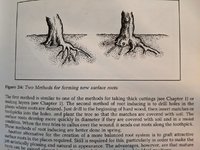Apex37
Chumono
So this is probably an older method I just hadn't heard of based on the age of the book, but in Bonsai: It's Art, Science, History, and Philosophy by Deborah Koreshoff she talks about a few methods to creating new surface roots. Essentially, one method it talks about is drilling holes to the hardwood in spots where you are wanting to grow new roots and then placing either a match or toothpick in that spot. Eventually the tree will try and callous over and will send out new roots along the toothpick/match.
I'm curious if any of y'all have tried this and the success with it? This was one I hadn't heard of before.
I'm curious if any of y'all have tried this and the success with it? This was one I hadn't heard of before.

